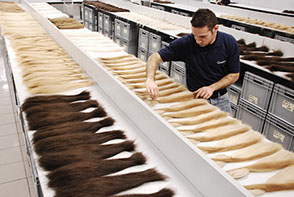
DE-PIGMENTATION
The hair undergoes a delicate process of de-pigmentation lasting 15 – 20 days.
The black pigments are slowly removed from inside the hair, not from the outside. The typical method of lightening/bleaching hair using ammonium derivatives damages the cuticle layer, thus compromising the hair’s texture and condition! Our de-pigmentation process does not damage the hair and permits the removal of the black pigment without altering the quality of the hair. The color molecules are actually removed rather than bleached.
OUR PIGMENTATION PROCESS
Great Lengths hair is subjected to a special process of pigmentation that does not require hair colour, peroxide, or bleach. Because our hair strands are not treated with harsh chemicals normally used to alter colour, the hair’s structural integrity, condition and texture are maintained. This process provides the wearer and the professional the luxurious, silky feeling of virgin hair that has consistent quality without colour variations coupled with a vast range of colors in the palette. The new pigment has a clean, empty space to occupy. This ensures that the molecule sits firmly in place and thus the colour will not fade out… just like your cashmere sweater!
THE COLOURIZATION PROCESS
The only processes performed on Great Lengths hair is our colourizing process. Great Lengths is the only Company that does not use any toxic chemicals (i.e. ammonia and/or bleach derivatives) in the de-pigmentation and re-pigmentation processes of our hair. The result is colour-fast hair that has not been subjected to damaging ammonia and/or bleach chemicals to remove the hairs original colour or to achieve the range of available colours.
The benefit of this GL patented process goes beyond the Great Lengths hair quality – it makes Great Lengths International the only Company that can factually state that there is no negative Eco impact from our production process. This point becomes magnified when compared to the significant negative eco impact created by all hair processing facilities, of which the overwhelming majority are located in China and Indonesia where there are no effective regulatory agencies to monitor such production.

